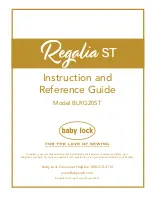
Aligning the needle bar linkage
48
Service Instructions 1767 - 00.0 - 12/2016
10 Aligning the needle bar linkage
Order
First, check the following setting:
• A straight and undamaged needle has to be inserted
(
Operating Instructions
)
Proper setting
1.
Set the stitch length adjusting wheel to
0
.
The needle pierces exactly in the center of the feed dog needle hole.
10.1 Aligning the needle bar linkage sideways
Cover
• Remove the arm cover (
• Remove the head cover (
• Disassemble the tensioning plate (
• Remove the front cover (
Fig. 34: Aligning the needle bar linkage sideways (1)
CAUTION
Risk of injury from moving parts!
Crushing possible.
Switch off the machine before aligning the needle
bar linkage.
(1)
- Threaded pins
(2)
- Adjusting rings
(3)
- Screw
①
③
②
Summary of Contents for 1767
Page 1: ...1767 Service Instructions ...
Page 6: ...Table of Contents 4 Service Instructions 1767 00 0 12 2016 ...
Page 10: ...About these instructions 8 Service Instructions 1767 00 0 12 2016 ...
Page 120: ...Decommissioning 118 Service Instructions 1767 00 0 12 2016 ...
Page 122: ...Disposal 120 Service Instructions 1767 00 0 12 2016 ...
Page 126: ...Technical data 124 Service Instructions 1767 00 0 12 2016 ...
Page 127: ......
















































